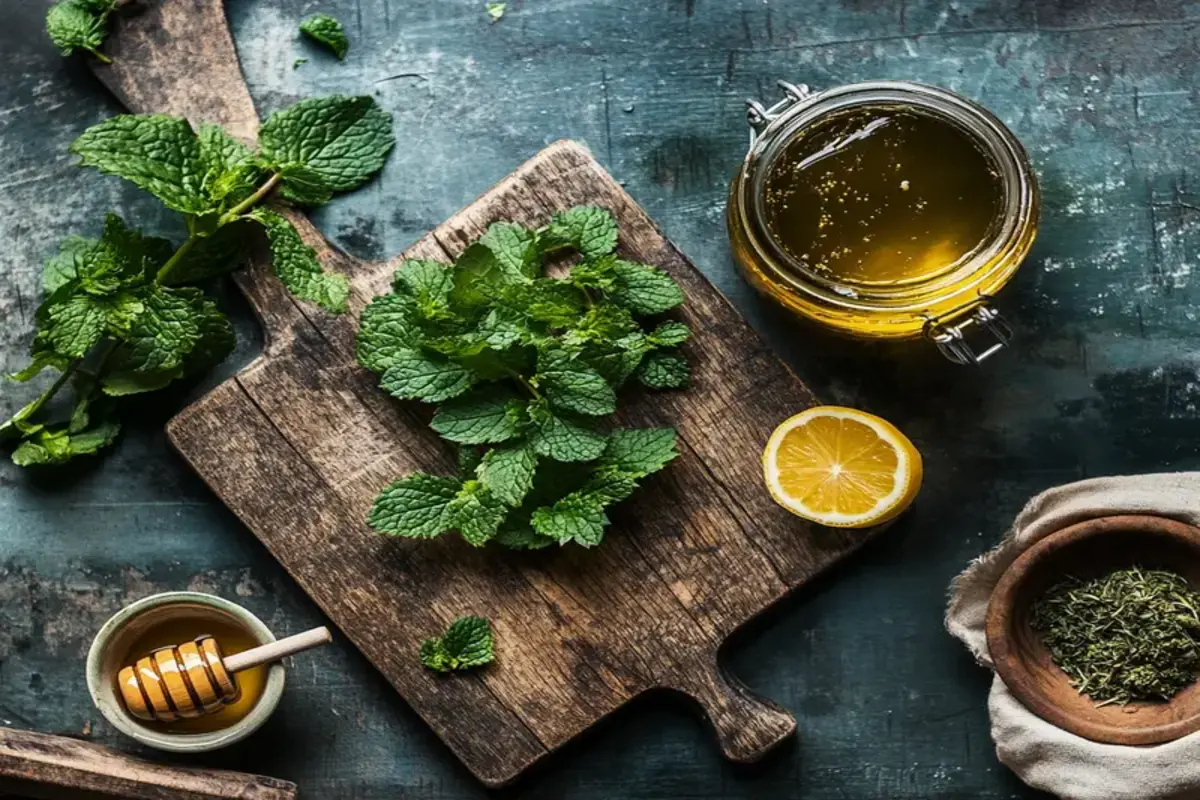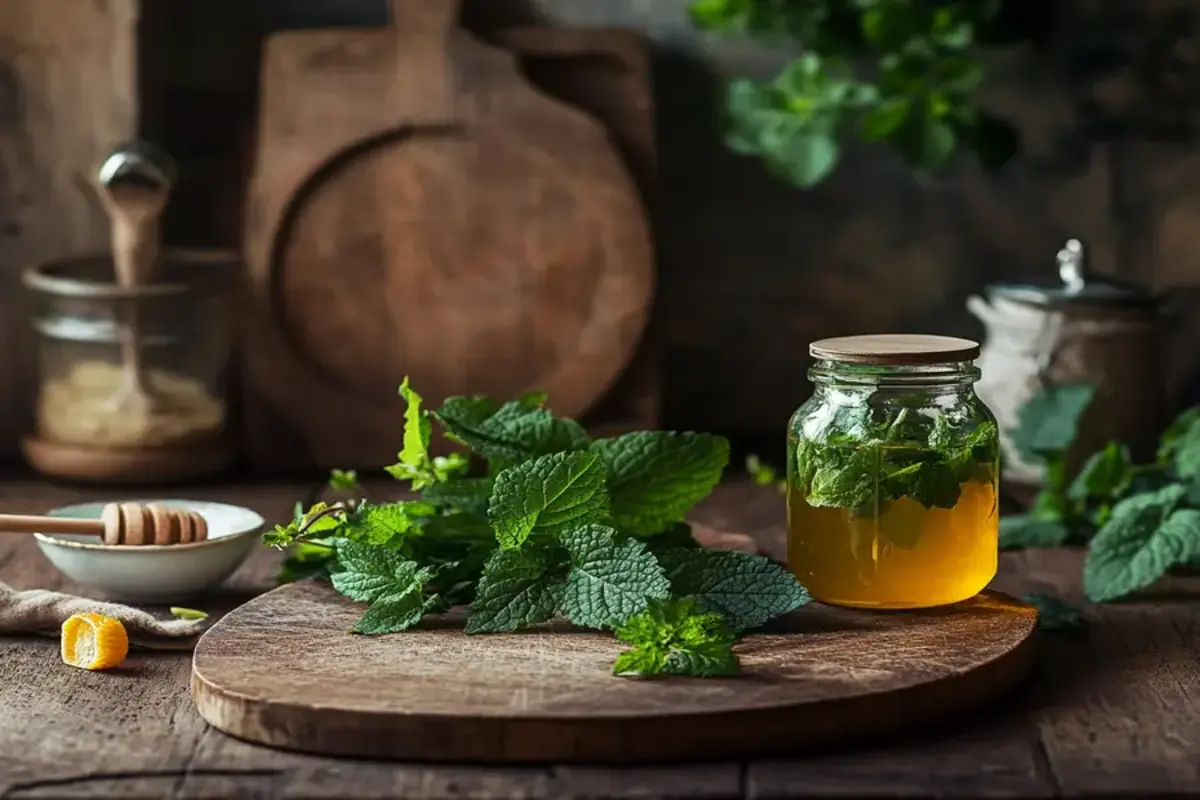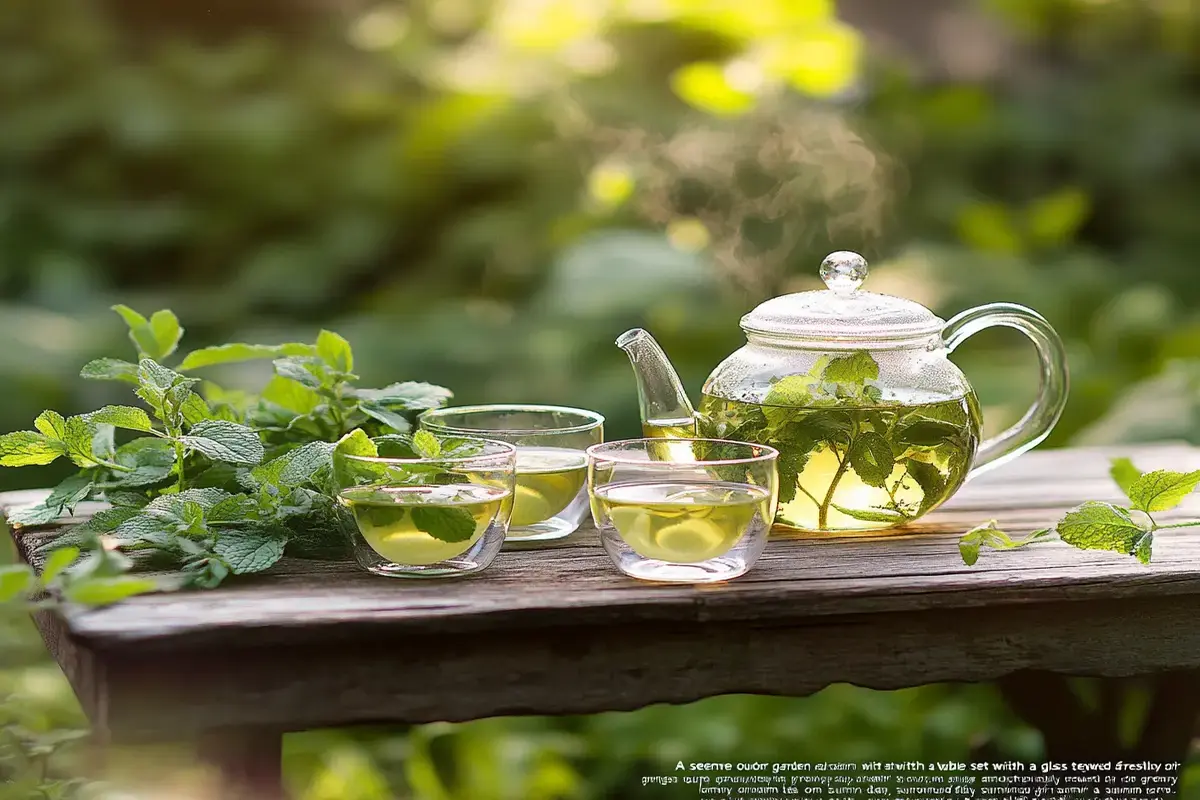Lemon balm, with its bright, citrusy aroma and soothing qualities, has been a cherished herb for centuries. From refreshing beverages to delightful desserts, this versatile plant offers endless possibilities in the kitchen. In this article, we’ll explore the wonders of lemon balm, covering its health benefits, growing tips, popular recipes, and practical uses. Whether you’re a seasoned chef or a curious beginner, you’ll find inspiration to incorporate lemon balm recipes into your culinary repertoire.
Introduction to Lemon Balm
What is Lemon Balm?
Lemon balm (Melissa officinalis) is a delightful herb from the mint family, cherished for its calming properties and citrusy aroma. This versatile herb is a star ingredient in many lemon balm recipes, bringing a fresh, zesty flavor to teas, desserts, and savory dishes. Whether you’re looking to relax with a soothing drink or add a unique twist to your cooking, lemon balm is an herb that deserves a spot in your kitchen.
Historical Uses and Cultural Significance of Lemon Balm
Throughout history, lemon balm has been prized for its healing and uplifting qualities. The Greeks and Romans infused it into wine for its refreshing taste and stress-relieving effects. During the Middle Ages, it was a key remedy for anxiety and insomnia. Today, its culinary uses have expanded, and lemon balm recipes now range from herbal teas to creative marinades.
Why Lemon Balm is Popular in Recipes Today
In modern cooking, lemon balm stands out for its ability to complement both sweet and savory flavors. Its gentle lemon-mint notes make it a favorite for herbal teas, desserts, and sauces. With its health benefits and culinary versatility, this herb is a natural choice for anyone seeking to create wholesome, delicious lemon balm recipes that delight the senses and nourish the body.
Let me know if you’d like me to continue with more sections!
Health Benefits of Lemon Balm
Stress Relief and Relaxation Properties
One of the most popular reasons to use lemon balm is its ability to ease stress and promote relaxation. This herb is rich in compounds like rosmarinic acid, which help calm the nervous system. A simple lemon balm recipe, such as tea, can create a sense of tranquility, making it a perfect addition to your self-care routine.
Digestive and Sleep-Enhancing Benefits
Lemon balm is also known for its gentle digestive benefits, making it ideal for soothing an upset stomach or aiding in digestion after a meal. Additionally, its mild sedative properties can help you fall asleep faster and enjoy deeper rest. A cup of lemon balm tea before bed or adding the herb to your recipes can support better digestion and sleep naturally.
Lemon Balm as an Anti-Inflammatory and Antioxidant Herb
Packed with antioxidants, lemon balm fights oxidative stress and reduces inflammation. This makes it a valuable herb for overall health. Incorporating it into a tea or lemon balm recipe not only enhances your meals but also supports your immune system and skin health.
How to Grow and Harvest Lemon Balm
Growing Lemon Balm: Tips for Beginners

Lemon balm is one of the easiest herbs to grow. Whether you have a spacious garden or just a small balcony, this resilient herb thrives in most conditions. It prefers full sun but can tolerate partial shade. Simply plant it in well-draining soil, water it regularly, and watch it flourish. Consider planting it near your kitchen for quick access to fresh leaves for your lemon balm recipes.
Harvesting Techniques for Fresh Leaves
When it’s time to harvest, snip the stems early in the morning when the essential oils are most concentrated. Focus on mature leaves—they’re packed with flavor and nutrients. Be gentle with the delicate foliage to avoid bruising. Whether for tea, salads, or marinades, freshly harvested lemon balm leaves are a fragrant and flavorful addition to your dishes.
Storing and Preserving Lemon Balm for Long-Term Use
Preserve the freshness of your lemon balm by drying the leaves. Use a dehydrator, oven, or simply air-dry them in a warm, shaded spot. Once dried, store the leaves in an airtight container away from sunlight. This ensures you’ll have access to its unique taste and benefits even in the off-season. Dried lemon balm is perfect for crafting teas and other flavorful recipes.
For more garden-to-table inspiration, you can explore related herb-based recipes, like Lemon Chicken Pasta recipe guide
Popular Lemon Balm Recipes
Refreshing Lemon Balm Tea Recipe
A classic way to enjoy lemon balm is by brewing a fragrant tea. This lemon balm recipe is simple yet soothing, perfect for winding down after a long day. To make it, steep fresh or dried lemon balm leaves in hot water for 5–10 minutes. Add a splash of honey or a slice of lemon for extra zest. Serve warm for a cozy drink or chill it for a refreshing iced tea. It’s a versatile recipe that highlights the herb’s calming properties and light citrus flavor.
Lemon Balm-Infused Desserts: Ice Cream and Sorbets
Lemon balm isn’t just for drinks; it works wonders in desserts too! Infuse its aromatic leaves into a custard base for creamy ice cream or blend it with fruits like berries and citrus to create a vibrant sorbet. These recipes are not only delightful but also bring a refreshing herbal twist to your sweet treats. Use them as a unique way to impress guests at your next gathering.

Savory Lemon Balm Dishes: Marinades and Salads
For a savory touch, try incorporating lemon balm into marinades or vinaigrettes. Its mild citrusy flavor pairs beautifully with chicken, fish, and even tofu. Whisk chopped leaves into olive oil, garlic, and a splash of lemon juice for a tangy salad dressing. Alternatively, use it as a fresh garnish for roasted vegetables. These savory applications show how versatile lemon balm can be in everyday cooking.
Creative Lemon Balm Uses: Jellies, Syrups, and Cocktails
Why stop at tea and desserts? Turn lemon balm into a homemade jelly to spread on toast or bake into pastries. Its subtle flavor also shines in syrups, perfect for drizzling over pancakes or sweetening cocktails. Speaking of drinks, muddle lemon balm leaves with sugar and lime juice to craft a refreshing mojito with an herbal twist. These creative lemon balm recipes open up a world of culinary possibilities.
Drying and Storing Lemon Balm for Recipes
Microwave Drying: A Quick Method
Pressed for time? Microwave drying is the fastest way to preserve lemon balm leaves. Arrange them in a single layer on a microwave-safe plate lined with a paper towel. Microwave on high for 30–40 seconds, checking frequently. Once the leaves are crisp and dry, store them in an airtight jar to use in any lemon balm recipe.
Traditional Sun and Oven Drying Techniques
For those who prefer traditional methods, sun-drying and oven-drying are excellent options. Spread the leaves on a baking tray and place them in a warm, shaded area for sun-drying. Alternatively, bake them at a low temperature (around 180°F) for 2–4 hours. Both methods ensure the leaves retain their flavor and aroma, making them perfect for teas and marinades.
Storing Dried Lemon Balm for Optimal Flavor Retention
To keep your dried lemon balm fresh, store it in an airtight container away from heat and sunlight. Glass jars work best, as they prevent moisture and maintain the herb’s aromatic qualities. Properly stored dried lemon balm can last up to a year, providing a steady supply for all your favorite lemon balm recipes. Whether you’re brewing tea or whipping up desserts, having dried lemon balm on hand is a culinary game-changer.
Looking for more ways to preserve and use herbs in recipes? Don’t miss our collection of pantry-friendly recipes for inspiration.
FAQs about Lemon Balm
What Do You Do with Lemon Balm?
Lemon balm is an incredibly versatile herb that can be used in a variety of ways. It’s popular for making soothing teas, but you can also use it in salads, marinades, desserts, and even cocktails. Adding lemon balm to your recipes not only enhances flavor but also brings its relaxing and digestive benefits to the table. Whether it’s a fresh garnish or the star ingredient in a lemon balm recipe, this herb is a must-have in any kitchen.
Does Lemon Balm Help Lose Belly Fat?
While lemon balm isn’t a magic weight-loss solution, its calming properties can indirectly support weight management. Stress often leads to overeating, and lemon balm’s ability to reduce stress might help control cravings. Additionally, lemon balm tea can aid digestion, which contributes to overall gut health. Combine it with a balanced diet and regular exercise for the best results.
Can I Drink Lemon Balm Tea Every Day?
Absolutely! Lemon balm tea is a gentle, caffeine-free beverage that’s safe for daily consumption. Its mild flavor makes it enjoyable morning or night. Drinking lemon balm tea regularly can help promote relaxation and better sleep, especially when incorporated as part of your nightly routine. For an easy lemon balm recipe, steep the leaves for 5–10 minutes and enjoy!
What Is the Magical Use of Lemon Balm?
In folklore, lemon balm has been associated with peace, love, and healing. It was believed to uplift spirits and attract positive energy. While these claims are anecdotal, lemon balm’s soothing properties can indeed create a sense of calm and well-being. Use it in teas or diffusers to bring its uplifting scent into your home.
Conclusion: Embracing Lemon Balm in Everyday Cooking
Why Lemon Balm Deserves a Place in Your Kitchen
Lemon balm is more than just a fragrant herb; it’s a powerhouse of flavor and wellness. Whether you’re looking to create a calming tea, whip up a refreshing dessert, or add a unique twist to savory dishes, lemon balm offers endless possibilities. Its ease of growth and versatility make it a must-have for home cooks and herbal enthusiasts alike.
Encouraging Experimentation with Lemon Balm Recipes
Don’t be afraid to experiment with lemon balm in your cooking. Start small by adding fresh leaves to salads or steeping them in drinks. As you grow more confident, explore more intricate lemon balm recipes, like syrups or marinades. The subtle lemon-mint flavor enhances both sweet and savory dishes, making it a delightful addition to your culinary creations.
By embracing this herb, you not only elevate your dishes but also enjoy its calming and health-boosting benefits. So, grab some lemon balm, and let your kitchen adventures begin!
Frequently Asked Questions About Lemon Balm
What Are the Common Uses of Lemon Balm?
Lemon balm has been a culinary and medicinal staple for centuries. It’s used to make soothing teas, enhance desserts, and flavor savory dishes like marinades and salads. Its mild lemony taste and calming aroma make it a favorite ingredient for teas and syrups. Additionally, lemon balm is often infused in oils or balms for its skin-soothing benefits. Whether fresh or dried, lemon balm elevates recipes and provides wellness perks.
Does Lemon Balm Help Lose Belly Fat?
While lemon balm isn’t a direct fat-burning herb, it may play a supportive role in weight management. Stress often triggers cravings, and lemon balm’s stress-relieving qualities can help curb emotional eating. Additionally, its digestive properties promote better metabolism and gut health, both of which are crucial for maintaining a healthy weight. Incorporating lemon balm tea or a refreshing lemon balm recipe into your diet could contribute to an overall balanced lifestyle.
Is Lemon Balm Safe for Daily Use?
Yes, lemon balm is generally safe for daily consumption in moderate amounts. Many people drink lemon balm tea daily to promote relaxation and better sleep. Its caffeine-free nature makes it an excellent choice for unwinding in the evening. However, as with any herb, moderation is key. Always consult a healthcare professional if you’re pregnant, nursing, or managing specific health conditions.
Lemon Balm for Everyday Wellness and Cooking
Lemon Balm’s Role in Wellness
a true multitasker in the world of herbs. It’s a natural remedy for stress and anxiety, thanks to its ability to calm the nervous system. Drinking lemon balm tea regularly can help regulate your mood, improve digestion, and promote restful sleep. These benefits, combined with its gentle detoxifying properties, make lemon balm a wonderful addition to a health-focused lifestyle.
Why Lemon Balm Recipes Are Worth Trying
The versatility of lemon balm in cooking cannot be overstated. Its lemon-mint flavor makes it suitable for teas, desserts, marinades, and even syrups. From simple dishes to more elaborate creations, lemon balm recipes allow you to experiment while enjoying its numerous benefits. For instance, making a batch of lemon balm-infused jelly or a zesty lemonade can be both fun and rewarding. Whether you’re trying to eat cleaner or simply spice up your meals, lemon balm is a flavorful choice.
By using lemon balm creatively, you not only enhance your recipes but also embrace its wellness benefits in a practical, delicious way. So the next time you ask, “Does lemon balm help lose belly fat?” remember its role in reducing stress and improving digestion—it’s a small but valuable step toward a healthier you.

